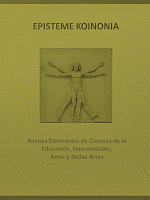Uso de los marcos CELTA para fomentar las habilidades del habla en el aula de inglés
DOI:
https://doi.org/10.35381/e.k.v5i9.1661Keywords:
Idioma de enseñanza, educación bilingüe, rendimiento escolar. (Tesauro UNESCO).Abstract
Este estudio tuvo como objetivo analizar el efecto de los marcos CELTA en el desarrollo de habilidades orales y motivación de estudiantes en un curso de inglés como lengua extranjera (EFL) de 4 meses en su último año, mientras se preparaban para un examen internacional de inglés. El estudio recopiló datos sobre el dominio del habla de los estudiantes en pre y postest. Los resultados mostraron un aumento significativo en la pronunciación, la fluidez, el vocabulario y la precisión gramatical de los estudiantes, así como también una motivación alta para hablar, confianza al usar el idioma y, un reconocimiento sobre la importancia del trabajo en equipo a través de la interacción con sus compañeros. Se concluyó que el uso de los marcos CELTA es un medio eficaz para fomentar la producción del lenguaje en el aula de inglés. Se incluyen recomendaciones para investigaciones futuras.
Downloads
References
Albino, G. (2017). Improving Speaking Fluency in a Task-Based Language Teaching Approach: The Case of EFL Learners at PUNIV-Cazenga. SAGE Open. https://doi.org/10.1177/2158244017691077
Al-Garni, S. A., & Almuhammadi, A. H. (2019). The Effect of Using Communicative Language Teaching Activities on EFL Students' Speaking Skills at the University of Jeddah. English Language Teaching, 12(6), 72-86. doi:10.5539/elt.v12n6p72
Balyasnikova, N., & Vasileva, O. (2019). (Re) Introducing Vygotsky’s thought: from historical overview to contemporary psychology. Frontiers in psychology, 1515. https://doi.org/10.3389/fpsyg.2019.01515
Borg, M. (2002). Learning to Teach: CELTA trainees' beliefs, experiences and reflections (Doctoral dissertation, University of Leeds). Retrieved from https://etheses.whiterose.ac.uk/1009/1/uk_bl_ethos_270670.pdf
Canale, M., & Swain, M. (2002). Theoretical bases of communicative approaches to second language teaching and testing. Applied Linguistics, 1(1), 1–47. https://doi.org/10.1093/applin/I.1.1
Deci, E. L., & Ryan, R.M (2000). Intrinsic and extrinsic motivations: Classic definitions and new directions. Contemporary Educational Psychology, 25(1), 54-67. https://doi.org/10.1006/ceps.1999.1020
Deci, E. L., & Ryan, R.M (2020). Intrinsic and extrinsic motivation from a self-determination theory perspective: Definitions, theory, practices, and future directions. Contemporary Educational Psychology, 61, Article ID: 101860. https://doi.org/10.1016/j.cedpsych.2020.10186
Digamon, J. S., & Cinches, M. F. C. (2017). Engagement Continuum in the work team experience: A pilot study. Nirwan Idrus, 15(3), 5. https://n9.cl/rvj14
Doane, D. P., & Seward, L. E. (2016). Applied Statistics in Business & Economics (5th ed.). New York, NY: McGraw Hill.
Dörnyei, Z. (2009). The 2010s Communicative language teaching in the 21st century: The ‘principled communicative approach’. Perspectives, 36(2), 33-43. www.zoltandornyei.co.uk/journal-articles
Ellis, R. (2003). Task-based language learning and teaching. Oxford university press. Retrieved from https://n9.cl/o01rk
Halliday, M. A. (2007). Language and Education. Continuum. Retrieved from https://n9.cl/c3s8l
Hymes, D. (2020). Pidginization and Creolization of Languages: Their Social Contexts. International Journal of the Sociology of Language, 2020(263), 99-109. https://doi.org/10.1515/ijsl-2020-2088
Kasap, B. (2005). The effectiveness of task-based instruction in the improvement of learners' speaking skills (Doctoral dissertation, Bilkent University). Retrieved from https://n9.cl/lim4k
Krashen, S. D. (1985). The input hypothesis: Issues and implications. Addison-Wesley Longman Limited.
Mangaleswaran, S., & Aziz, A. A. (2019). The impact of the implementation of CLT on students’ speaking skills. International Journal of Scientific and Research Publications (IJSRP), 9(4), 74-85. doi:10.29322/IJSRP.9.04.2019.p8814
Mohammed, A. E. T (2020). Original Paper Challenges of Applying the Teaching Methodology of (CELTA) Productive Skills in a Poor Learning Environment and a Fragile Infrastructure Region of Darfur, Sudan. Studies in English Language Teaching, 8(1), 53-65. doi:10.22158/selt.v8n1p53
Mohammed, A. E. T. (2021). The Impact Of Celta Course On Enriching EFL Students’ Vocabulary Learning With Reflection To The Guided Discovery Sheet Approach. Multicultural Education, 7(1), 17-27. https://10.5281/zenodo.4410663
Nunan, D. (1989). Designing tasks for the communicative classroom. Cambridge university press. Retrieved from https://n9.cl/e5g7l
Panhwar, A. H., Baloch, S., & Khan, S. (2017). Making communicative language teaching work in Pakistan. International Journal of English Linguistics, 7(3), 226-234. doi:10.5539/ijel.v7n3p226
Mahmadun-Nuby, M. H., Ab Rashid, R., & Hasan, M. R. (2019). Practices and Outcomes of Communicative Language Teaching in Higher Secondary Schools in Rural Bangladesh. Qualitative Research in Education, 8(2), 148–181. https://doi.org/10.17583/qre.2019.4093
Richards, J. C. (2005). Communicative language teaching today. Singapore: SEAMEO Regional Language Centre. Retrieved from https://n9.cl/hy388
Saeed, S., & Zyngier, D. (2012). How motivation influences student engagement: A qualitative case study. Journal of Education and learning, 1(2), 252-267. http://dx.doi.org/10.5539/jel.v1n2p252
Scrivener, J. (2005). Learning teaching. Oxford: Macmillan. UK
Scrivener, J. (2011). Learning teaching. 3rd edition. Oxford: Macmillan. UK
Vygotsky, L. S. (1934). Thinking and Speech. In R. W. Rieber & A. S. Carton (eds.)., The Collected Works of L. S. Vygotsky, Vol. 1, Problems of General Psychology, 39-288. New York: Plenum Press.
Yildiz, Y. (2020). Task-Based language teaching: An approach in the spotlight to propel language learning forward. International Journal of Social Sciences & Educational Studies, 7(1), 72-77. http://eprints.tiu.edu.iq/247/
Published
How to Cite
Issue
Section
License
CC BY-NC-SA : Esta licencia permite a los reutilizadores distribuir, remezclar, adaptar y construir sobre el material en cualquier medio o formato solo con fines no comerciales, y solo siempre y cuando se dé la atribución al creador. Si remezcla, adapta o construye sobre el material, debe licenciar el material modificado bajo términos idénticos.
OAI-PMH URL: https://fundacionkoinonia.com.ve/ojs/index.php/epistemekoinonia/oai







